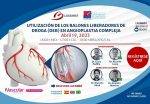Balloon pulmonary angioplasty: Evolution over time and its complications Balloon pulmonary angioplasty (BPA) has grown from its beginnings as an indication for patients with chronic thromboembolic pulmonary hypertension (CTEPH) to being currently a class 1 indication for inoperable patients and/or residual CTEPH. Current evidence on this topic is underpowered, as most reports are based on...
AQCA Study: Pre-PCI Virtual QFR for Planning PCI vs. Conventional Angiography
Several studies have used physiological assessment after a percutaneous coronary intervention (PCI) to improve clinical outcomes. However, results are not entirely conclusive. The limitations of using these physiological assessment methods are the need for extra measurements with increased procedure time, more radiation, and more contrast, which in turn leads to higher costs. To counteract these...
04/19 – SOLACI-LATAM Bif Webinar | Use of Drug Coated Balloons in Complex PCI
On Wednesday, April 19th, at 7 pm (Argentinian/Brazil time) we will be holding a new open event together with LATAM Bif on the “Use of Drug Coated Balloons in Complex PCI”. The event will feature renowned Latin American speakers and panelists. April 19, 2023, 7:00 pm (Argentinian/Brazil time; UTC-3). Open and free of charge. Take...
ACC 2023 | RENOVATE-COMPLEX-PCI: Intravascular Imaging-Guided vs. Angiography-Guided Complex PCI
Patients with complex coronary artery disease (CAD) undergoing percutaneous coronary intervention (PCI) have worse clinical outcomes tan patients with non-complex CAD. Several studies have shown that the use of intravascular imaging (IVUS, OCT) have reduced major adverse events vs. angiography guided PCI. However, these studies present limitations both of size, studied population, short term followup...
Microvascular Dysfunction in Symptomatic Patients with Intermediate Coronary Lesions Prognostic impact according to different patterns
Coronary microvascular dysfunction (CMD) is emerging as an important cause of myocardial ischemia, and its role in the pathogenesis of cardiovascular disease—including angina patients with nonobstructive coronary lesions—is well known. Currently, there are several definitions of CMD and several invasive and noninvasive diagnostic tests. Using invasive tests, heterogeneous patterns of microvascular dysfunction, such as coronary...
Left Main Revascularization: 12 Year Registry in Canada
The current indication for severe left main lesion continues to be coronary artery bypass graft surgery (CABG) but percutaneous coronary intervention (PCI) has come far in this territory thanks to increasing operator experienced and the use of IVUS during procedures. At present, left main disease have a Class IIa indication in the American guidelines when...
Is Using Drug-Eluting Balloons and Single Antiplatlelet Therapy Safe for Patients at High Risk for Bleeding Who Undergo Percutaneous Coronary Intervention?
The safety and efficacy of drug-coated balloons (DCB) has been established for the treatment of in-stent restenosis of conventional bare-metal stents (BMS) and drug-eluting stents (DES). Furthermore, these devices are also used to treat de novo coronary lesions, as demonstrated in the BASKET-SMALL 2—where DCBs were non-inferior to stents—and the DEBUT RCT trials—, where DCBs...
Can Drug Coated Balloon Be a Valid Option for Small Vessels?
One of the challenges of percutaneous coronary interventions (PCI) are <2.5 mm vessels, since complications and restenosis complications rate are higher than with >3.0 mm vessels. Drug Coated Balloons (DCB) can be a useful tool, but their efficacy and safety [vs. plain old balloon angioplasty] remains unclear. PEPCAD China SVD is a prospective and multicenter...
Left Main Coronary Artery Percutaneous Coronary Intervention: Evolution and Results over Time
Left main coronary artery percutaneous coronary intervention (LMCA PCI) is a treatment option that is increasingly used in our setting. One of the reasons for choosing this therapeutic strategy is the improvements in devices and techniques. However, the long-term results of LMCA PCI are not well established. The aim of this retrospective study was to...
Is Rehospitalization a Relevant Factor after Aortic Valve Replacement?
Patients with severe symptomatic aortic stenosis treated with aortic valve replacement might still present cardiac failure, even after successful procedures. According to some reports, the incidence of cardiac failure after TAVR varies between 9% and 24%. The prognostic relevance of rehospitalization in these patients has not been studied yet; in fact, it remains unclear whether...








